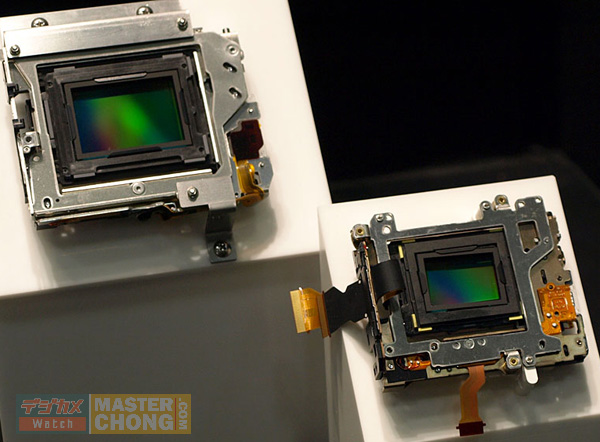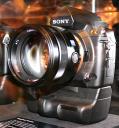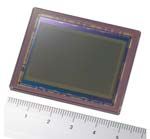With all this talk about existing Full-Frame photo cameras (Canon EOS 5D, Nikon D3) and about possibly upcoming new ones (Sony Alpha 900, Canon EOS 5D Mk II or some other similar name, etc.) many photographers happy with their existing digital equipment are wondering: “What’s all the fuss about?”
And it’s a good question to ask, but the answer goes with some of the comments about sensor resolution. About the same people who noticed that resolution is not all that counts (despite what is said or implied by some of the major brands on this market) also understand that going Full Frame is a possibly very important decision for the attentive digital photographer.
WTF is Full Frame?
First you’d like to understand what we are speaking about – precisely. Most Digital Single Lens Reflex (D-SLR) cameras use a sensor whose size is about half of the size of a usual (old?) 35mm film frame. We call them APS-C-sized sensors because it’s not far from the (younger but still old?) APS-C film frame size. Since so many photographers have been trained in the world of 35mm films, everything tends to be compared to it.
![]() Those small sensors are used by camera manufacturers because the smaller the silicon chip, the cheaper it goes. This is the main reason why phone cameras use even smaller sensors (a few millimeters wide for some of them).
Those small sensors are used by camera manufacturers because the smaller the silicon chip, the cheaper it goes. This is the main reason why phone cameras use even smaller sensors (a few millimeters wide for some of them).
Full Frame sensors are those ones that are nearly exactly the same size as a 35mm film: 24mm by 36mm sensitive surface. By silicon manufacturing standards this has long been too big to be reasonably manufactured in large quantities but progress being what it is in this industry (Moore’s law, you know?) it is now becoming feasible. So why not?
The pros of FF
The first one is that if you stick to a fixed number of pixels (say 10 millions of them on one single sensor), the wider the sensors, the larger the individual pixel sensitive element. This has several enormously interesting advantages.
Being big, the pixel is also much more sensitive (it can collect more photons at the same time). So, there is less need to do mathematics and algorithmics to compensate for low light situations. The sensor collects directly enough light and the image is less impacted by noise. Like when you push the volume up on a radio to hide the background noise of a conversation. Those big pixels naturally “push the volume up”.
And noise is a real problem. On very high ISOs and/or on low quality cameras (read “small sensors” like we find them in camera phones or even compact point-and-shoot cameras), you keep shooting images that are dull, covered with little colored specks or lack in details because the camera manufacturer forced on “noise cleaning algorithm” and this removed most details.
Parallely, if you pixel is large and collecting a lot of light photons, it is easier for the electronics to cut it in small pieces: you get better dynamic range. It means that you will find easily more details in the dark areas of the image and you will mostly avoid the blown-out white zones of some light areas. This is a good thing for your photos.
But there are also some other even more subtle but important issues at hand. Many photographers migrating from analog to digital SLR cameras have noticed that the viewfinder now looks like a tiny little tunnel: everything seems to be small and dark. Since the sensor image is smaller, it is sent back to the eye in a smaller size too. It is uncomfortable unless you invest in a camera with a top of the line viewfinder. But if the sensor is Full Frame, it is easier for the camera manufacturer. They don’t have to enlarge the image, it’s already big.
A much more technically difficult argument is something that is now cropping up with large pixel numbers. When we had 6 million pixels on an APS-C sensor, nobody noticed it, but with 10, 12, 14 millions pixels people start to notice that the increase of resolution does not always go with improved image quality. One of the reasons is linked to light diffraction when you close the diaphragm. The pixels are getting so small that the slight diffraction from a lens closed at f/22 or f/16 is becoming larger than a pixel (or at least perceptible there).
Manufacturers (and intensely attentive photographers) now understand that if they want to keep getting more pixels, they -first- have to buy extra-high-quality lenses (at a price) and -second- they must get bigger pixels (and bigger sensors). 20 million pixels on an APS-C sensor will probably never be significantly better than 10-12 millions of them. You have to go to Full Frame if you want more pixels! It essentially gives you more real pixels and an extended diaphragm range: in most cases, it is understood that around 12 millions pixel on an APS-C sensor, closing to more than f/16 is just breaking down your picture.
As a side note, this also explains why so many small cameras and phone cameras are producing really ugly images out of an astonishing number of pixels…

Questionable advantages
Another bane of small sensors is that they have so much Depth of Field (DOF). Everything seems to be in focus. This is good for a digital photo notebook like your camera phone. But if you want to go a little more on the artsy side, you may want to ensure that the subject is neatly focused and leaving the background in a warm fuzzy light. This is more difficult with APS-C sensors than with full frame sensors. However, you have to admit that this is a mixed advantage. For example, macro photography is always lacking in depth of field. APS-C has been bringing a little advantage here.
Also, APS-C sensors being smaller, they tend to crop the image. So, the standard 50mm lens you used on the old analog camera looks like it is giving you the same image as your old 75mm or 80mm short tele lens when mounted on a Digital SLR camera. This is what is called the crop factor. Depending on your camera (or, more precisely, its sensor), it gives you a small conversion factor (1.6 for most Canon EOS, 1.5 for most Sony and Nikon). This is a nightmare for people in love with wide angle lenses and wide panoramas (it’s becoming more and more difficult to get a wide angle lens: super wide 16mm now looks like a wide 24mm). Many nature landscape photographers suffer from that change. However, being a wildlife photographer myself, I admit that this can be good too: My collection of tele-lenses got a boost going from Minolta analog to Sony digital; The latest addition, a 400mm f/4.5, is nearly exactly equivalent on my Sony Alpha 700 to a 600mm f/4.5 on the old Minolta Maxxum 9xi but it is about half the weight and half the price). Not everybody can be happy with that.
The dark side of the Full Frame
But there are also very bad aspects of these large Full Frame sensors. First, we already said that electronics manufacturing is utterly sensitive to surface. The larger a chip, the more expensive. And not only because of the added material. Defects on a silicon chip tend to be spread quite evenly on its surface. The larger it is, the more defects you have, the more difficult it becomes to manufacture, the more parts you have to scrap (if your chip is twice bigger, a single defect will kill it, but on a smaller one, you would get one good chip and one bad one). Price increase has long been so large that it is not mentionable. Now, things are a bit easier, but… it’s expensive.
Also to mention, bigger sensors mean bigger cameras (your phone camera is small because its photo sensor is small). Bigger means heavier. There is a definite difference between a 300g camera body and 800g camera body. Keep it for more than an hour while shooting! Some photographers may not really care (I often hold a camera behind a lens that is more than 2kg -I previously mentioned a 400mm lens of 2.9kg- and I’ve got used to it but many people would not even think about it. The first time I bought a second-hand Sigma 400mm/5.6 the previous owner was selling it because he had a back ache prohibiting to use it).
 But you could also say that you don’t really care if the image is good. And here comes the size of the lens again. To cover the full surface of a Full Frame sensor you need a lens that is large enough for that. It must also be of perfect quality to the extreme corner of the image. But if you get the light in all corners you also have to ensure that the light rays are not suffering from too many angled paths through the lens. If you do not make sure of this during the design, it’s easy to get a correct lens for APS-C, but a pitifully bad one for Full Frame. Quite often, these are difficult goals to reach and you get vignetting (the corners of the image are a little darker than the center) and soft corners (zones that are not as crisp as the center of the image). The larger the sensor, the more difficult to make a good lens for it (again). You go to the pro-quality lenses. Again, there is a price hike and added weight on the scale.
But you could also say that you don’t really care if the image is good. And here comes the size of the lens again. To cover the full surface of a Full Frame sensor you need a lens that is large enough for that. It must also be of perfect quality to the extreme corner of the image. But if you get the light in all corners you also have to ensure that the light rays are not suffering from too many angled paths through the lens. If you do not make sure of this during the design, it’s easy to get a correct lens for APS-C, but a pitifully bad one for Full Frame. Quite often, these are difficult goals to reach and you get vignetting (the corners of the image are a little darker than the center) and soft corners (zones that are not as crisp as the center of the image). The larger the sensor, the more difficult to make a good lens for it (again). You go to the pro-quality lenses. Again, there is a price hike and added weight on the scale.
So what?
In the end, the choice to go Full Frame is currently reserved to prosumers or top-flight amateurs or even pro photographers. But we have to keep in mind that the trend will be going there just to keep the quality while other factors are climbing. Don’t believe that electronics progress will remove all limits (diffraction is an optical phenomenon we have to live with). Not everybody will have to go there, but Full Frame is there to stay.
You may not want to invest in Full Frame, but you must take that into account when you buy a lens. Many cheap lenses are only able to serve APS-C sensors. While this was a sensible investment (pay less for the same service), remember that a good lens is supposed to live much longer than your camera (digital cameras have gone the way of computers: 2-year obsolescence is the standard). This is why so many Full Frame (even second-hand) lenses are keeping a high market price. This is why Sony and Carl Zeiss still only manufacture lenses able to work on both APS-C and FF.
When I buy a tele lens, I tend to pay a hefty price on second-hand hardware (more than 2000 Euros on the old second-hand Minolta APO G High-Speed 400mm f/4.5 I got from eBay). I intend to keep that much longer than the Sony Alpha 700 and the Konica-Minolta Dynax/Maxxum 7D I use as SLR bodies behind it. If (and I say if) I go and buy the future Sony Alpha 900 Full Frame camera which is supposed to be available some time this year, possibly at the end of the Summer 2008, all my lenses will still be compatible with this camera body.
So, even if you don’t care about the added quality, think about the rest of your investment in the context of Full Frame sensors.

Leave a Reply